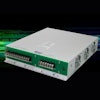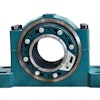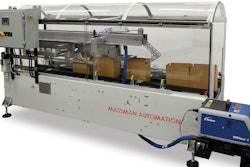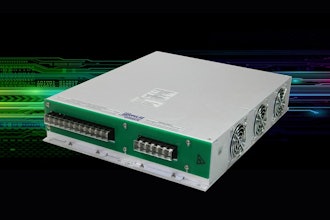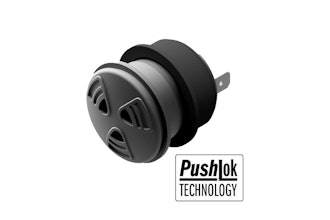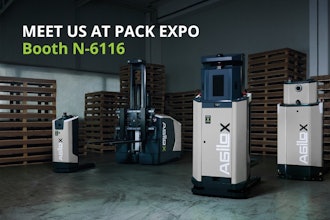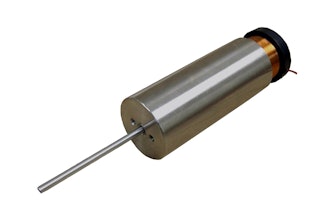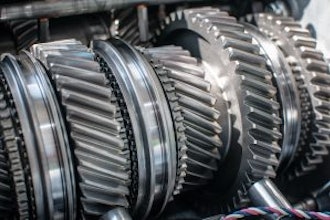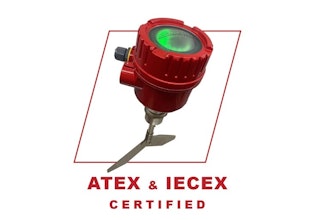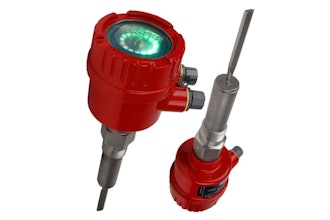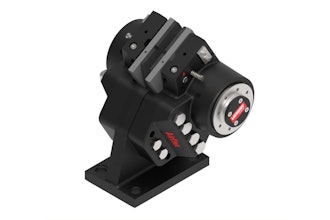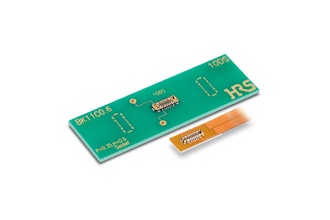Kocsis Technologies, Inc., manufacturer of hydraulic starters, supplies reliable, robust, and green starting systems for a wide range of engines, from about 50 to 6,000 hp. Part of their research and development effort in developing new, larger sized starters to accommodate larger engines is applying a load equal to the mass of the engine that must be started -- the load that the starter must overcome.
Rather than buying commercial engines to apply this load, which would require a staggering number of engines plus installation each time one was installed/removed, the company developed a dynamometer using an oil-shear brake from Force Control Industries. The Positorq TB20 brake applies a load which can be precisely controlled in real time, yielding very accurate data even with loads of up to 8,000 ft-lb. In addition, the test stand can operate continuously and test cycle times have been slashed from 2 to 3 minutes to about 20 seconds.
Oil Shear Technology: Pretty Cool
Decreased cycle times coupled with continuous operation produces a drastic increase in the number of cycles achieved per year. Oil sheartechnology is the key to both of these. The previous design used a standard friction-style dry brake, which the company could test for about 2 hours before experiencing brake fade due to friction disc glazing caused by high heat.
"The friction material was so hot that you could grab the rotor and nothing would happen," says engineering manager and test stand designer Todd Peterson. The air-cooled brake relied on a fan behind it to blow air, which would help dissipate the heat. Unfortunately for Kocsis Technologies personnel, the room containing the test stand was not climate controlled, so the ambient temperature would rise during testing -- with the air blown over the brake to dissipate heat also steadily rising in temperature.
"It would get to the point where the rotor would glow," recalls Peterson. "We were always limited with friction brakes because we could not scrub the heat out."
Overall the company could test for only about 2 hours before shutting down the test stand and allowing the components to cool. Rather than merely trying larger and larger dry friction brakes, Peterson started with a clean slate and redesigned the stand from scratch. He replaced the dry brake with the oil shear brake, which is inherently cooler running. The new system is capable of 24/7 operations - and equally impressive, cycle times have been reduced from 2 to 3 minutes to about 20 seconds. The result is a significantly higher number of test cycles per day.
"Our cycle is applying a load to the starter, turning the load off, going to a dwell period, and then back to the load," said Peterson. "The dramatic increase in cycles/day allows us to perform longevity and durability testing."
Fluid is pumped through the multiple disc stacks to provide both lubrication and heat dissipation. Elimination of the heat improves brake consistency, while providing longer life with virtually no adjustment required.
How Oil Shear Technology Works
Normal dry brakes employ a sacrificial surface -- a disc or pad -- to engage the load. Having no good way to remove the heat caused from engagement between the disk and plate, this material must absorb the heat. These extremely high temperatures will eventually degrade the friction material. As the friction surface wears away and begins to glaze, it causes torque fade.
Oil shear technology plays a major role in ensuring that the Kocsis Technologies test stand can operate continuously. The Positorq brake consists of a multiple stack of friction discs and drive plates of a size and number needed to produce the required torque and absorb the energy.
Transmission fluid is pumped through the inner hub, pushing the fluid through the friction stack and back into the housing, where it flows into a separate Forced Lube Cooling Unit.
As the plates and discs are compressed together, the fluid film is put in a state of shear and will transmit torque between the two parts. The torque transmitted is directly related to the pressure applied to squeeze the stack together.
The Forced Lube Cooling Unit consists of a reservoir for de-aeration, heat exchangers for cooling, and filters for cleaning the fluid. The cool filtered fluid continues back through the brake, completing the cycle.
In addition to transmitting torque, much of the heat generated is developed within the fluid in shear, which is removed from the stack and replaced by cooled fluid. This keeps the friction surfaces cooled, eliminating fade and severe friction material degradation due to excessive heat.
Along with torque transmission and heat removal, the fluid also serves to continually lubricate all components such as bearings and splines, thus extending their service life. With elimination of wear comes elimination of repair and rebuild, allowing Positorq brakes to operate for years (or decades) before any repair or parts replacement is required. This means increased uptime for the hydraulic starter test stand.
No Slip-Ups in Continuous Slip
Even more impressive, this is a continuous slip application, meaning that the starter spins continuously under a very high load.
"Many applications are trying to slow down and then stop a conveyor belt or some other device," said Peterson. "Our application is designed to slow down but never fully stop it -- so it is a very severe duty cycle on the brake. The duty is so severe that a brake with oil shear technology was the only way to go."
The continuous operation of the test stand is impressive, especially considering where Kocsis Technologies, Inc. started. But Peterson is quick to point out that the biggest advantage of the oil shear technology is "control. We can control it in real time. We can modulate the actual stopping force of the brake much differently than we could with a standard cookie cutter friction brake."
Positorq® brakes are quiet, with noise levels of the brake system below 65 db, which is important because test personnel are typically nearby. The totally enclosed design eliminates any contaminants to the area from friction materials or other materials.
Since the effective radius, number of discs, and friction factor remain constant, the torque available is directly equivalent to the actuation pressure (air or hydraulic) furnished to the actuating piston. With multiple braking surfaces, the Positorq® is not only compact but also low inertia.
That control, coupled with the ability to run 24/7, is helping Peterson strive toward another goal - lights-out testing.
"When we're doing R&D, our engineering staff has a very high internal hourly rate. Our goal is to transition to literally lights-out testing. We have enough intelligence in the HPU unit that it will turn itself off based on known events, like a broken hydraulic hose. The stand itself has an amazing amount of intelligence built into it. We can turn it on, then remotely control it from our intranet internally or the Internet externally."
That will enable Kocsis Technologies, Inc. to transition to long-term continuous duty cycle durability testing -- a project that is becoming reality in part because the oil shear brake, unlike its dry brake predecessor, never needs adjustment. You might say that the oil shear brake enabled the company to catch a good break in terms of future product development.


